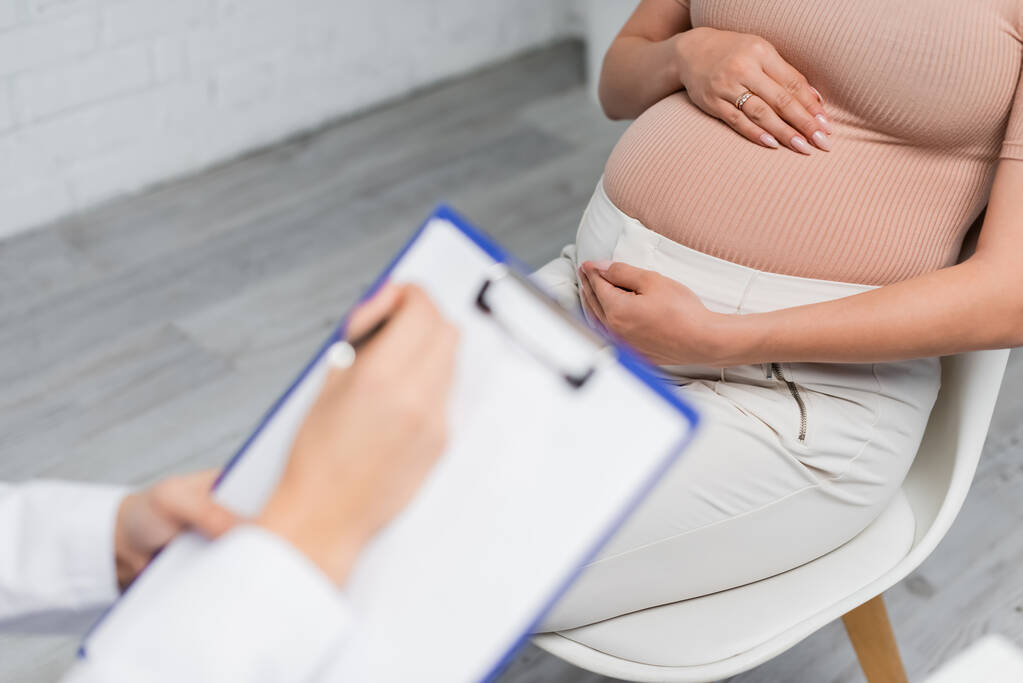Discover the potential side effects and concerns associated with using a maternity belt.
Are There Any Side Effects or Concerns When Using a Maternity Belt?
In recent years, maternity belts have become increasingly popular among expectant mothers. These specially designed support garments can provide much-needed relief during pregnancy, helping to alleviate discomfort and support the growing belly. However, as with any product, it is important to understand the potential side effects and concerns that may arise when using a maternity belt. In this article, we will delve deeper into the purpose of maternity belts, explore their role in pregnancy, discuss potential side effects, address health concerns, highlight safe and proper use, and emphasize the importance of consulting healthcare professionals.

Understanding the Purpose of a Maternity Belt
Before diving into the potential side effects and concerns, it is crucial to understand the purpose of a maternity belt. These ingenious inventions are designed to provide support to the belly, lower back, and pelvic area during pregnancy. By offering gentle compression, a maternity belt helps to distribute the weight of the baby more evenly, reducing strain on the back and relieving discomfort that often accompanies pregnancy.
The Role of Maternity Belts in Pregnancy
Maternity belts play a crucial role in providing stability and support during pregnancy. As the baby grows, the extra weight puts increased pressure on the lower back and pelvis, often leading to lower back pain, sciatica, and pelvic pain. A maternity belt helps to alleviate these discomforts by offering support to the abdominal muscles and reducing the strain on the ligaments.
During pregnancy, the body undergoes numerous changes to accommodate the growing baby. The ligaments in the pelvic area become more relaxed, allowing for the expansion of the uterus and the baby’s growth. However, this increased flexibility can also lead to instability and discomfort. Maternity belts help to counteract this by providing external support to the pelvic region, reducing the risk of strain and injury.
Additionally, as the belly expands, the center of gravity shifts, putting more pressure on the lower back. This can result in lower back pain, which is a common complaint among pregnant women. Maternity belts help to alleviate this pain by providing gentle compression and support to the lower back muscles. By stabilizing the spine and reducing the strain on the muscles, maternity belts can significantly reduce discomfort and improve overall well-being during pregnancy.
How Maternity Belts Provide Support
Maternity belts are typically made of elastic fabric and are adjustable to accommodate the changing shape of the belly throughout pregnancy. They are designed to be worn just below the belly, wrapping around the lower back and hips, providing compression and support to these areas. The gentle pressure exerted by the belt helps to stabilize the joints and muscles, reducing pain and discomfort.
Moreover, maternity belts are designed to be comfortable and breathable, allowing for ease of movement and preventing excessive heat and moisture buildup. They are often equipped with adjustable straps or Velcro closures, allowing pregnant women to customize the fit according to their comfort level and changing body shape.
It is important to note that maternity belts should be worn correctly to ensure optimal support and effectiveness. The belt should be snug but not too tight, allowing for proper circulation and freedom of movement. Pregnant women should consult with their healthcare provider or a maternity belt specialist to ensure they are using the belt correctly and benefiting from its full potential.
In conclusion, maternity belts are invaluable tools for pregnant women, providing much-needed support and relief from the physical discomforts associated with pregnancy. By distributing the weight of the baby more evenly, reducing strain on the back, and stabilizing the pelvic area, maternity belts can significantly improve the overall well-being of expectant mothers.
Potential Side Effects of Using a Maternity Belt
While maternity belts are generally safe to use, there are potential side effects that expectant mothers should be aware of. It is important to note that these side effects may vary from person to person, and not all women may experience them.
Physical Discomfort and Skin Irritation
Some women may find that wearing a maternity belt for extended periods of time can cause physical discomfort, such as tightness or pressure on the abdomen. This discomfort can be attributed to the compression of the belt on the growing belly, which may lead to a feeling of constriction. However, it is important to note that this discomfort is usually temporary and can be alleviated by adjusting the tightness of the belt.
In addition to physical discomfort, wearing a maternity belt against bare skin can sometimes lead to skin irritation or rashes. This can occur due to the friction between the belt and the skin, especially if the belt is made of a material that does not allow proper ventilation. To minimize these issues, it is recommended to wear a thin cotton shirt underneath the belt. The cotton fabric acts as a barrier between the belt and the skin, reducing the risk of irritation.
Dependency and Muscle Weakness
Another potential side effect of using a maternity belt is the risk of developing dependency and muscle weakness. The constant support provided by the belt may cause the muscles surrounding the lower back and pelvic area to become reliant on the belt’s support, leading to a decrease in their strength and functionality over time.
To prevent this, it is essential to balance the use of the maternity belt with exercises that strengthen the core and pelvic muscles. Engaging in regular prenatal exercises, such as pelvic tilts, squats, and gentle yoga poses, can help maintain muscle strength and prevent dependency on the belt. These exercises not only strengthen the muscles but also improve overall posture and stability, which are crucial during pregnancy.
Furthermore, it is important to consult with a healthcare professional or a certified prenatal fitness instructor to ensure that the exercises performed are safe and suitable for individual circumstances. They can provide guidance on the appropriate intensity and frequency of exercises, taking into consideration factors such as gestational age, fitness level, and any pre-existing conditions.
By incorporating these exercises into a daily routine and using the maternity belt as a temporary support tool rather than a long-term solution, expectant mothers can minimize the risk of muscle weakness and dependency on the belt.
Health Concerns Associated with Maternity Belts
While maternity belts are generally safe for most women, there are a few health concerns that should be taken into consideration.
Maternity belts have become a popular accessory for pregnant women, providing support and comfort to the growing belly. However, it is important to be aware of potential health risks that may arise from improper usage or prolonged wear.
Impact on Fetal Development
Some concerns have been raised about the potential impact of wearing a maternity belt on fetal development. However, current research suggests that maternity belts do not pose any significant risk to the baby when used correctly and in moderation.
Experts recommend that pregnant women consult with their healthcare providers to ensure safe and appropriate usage based on their individual circumstances. This includes considering factors such as the stage of pregnancy, any pre-existing conditions, and the overall health of both the mother and the baby.
It is important to note that maternity belts are designed to provide gentle support and relieve pressure on the lower back and abdomen. When worn correctly, they should not interfere with the natural growth and development of the fetus.
Circulation and Digestive Issues
Another health concern associated with maternity belts is the potential for circulation and digestive issues. Wearing a maternity belt that is too tight or for an extended period of time can potentially cause poor circulation and digestive discomfort.
It is crucial to ensure that the maternity belt is not overly constrictive. The belt should be snug enough to provide support but not so tight that it restricts blood flow or puts excessive pressure on the abdomen. Adjusting the belt to the right level of tightness is essential for maintaining optimal comfort and avoiding any potential health issues.
Pregnant women are advised to take breaks from wearing the maternity belt throughout the day. This allows for healthy blood flow and digestion, preventing any potential complications. It is recommended to consult with a healthcare provider to determine the appropriate duration of wearing the belt and the frequency of breaks needed.
Additionally, maintaining good posture and engaging in regular exercise during pregnancy can help alleviate the risk of circulation and digestive issues associated with maternity belts. These practices promote overall health and well-being for both the mother and the baby.
In conclusion, while there are some health concerns associated with maternity belts, they can be safely used by most pregnant women when used correctly and in moderation. It is important to consult with a healthcare provider for personalized guidance and to ensure the well-being of both the mother and the baby.
Safe and Proper Use of Maternity Belts
To mitigate any potential side effects, it is crucial to use maternity belts safely and correctly.
Correct Sizing and Positioning
Choosing the right size maternity belt is crucial for optimal support and comfort. It is recommended to follow the manufacturer’s guidelines when selecting a size. Additionally, positioning the belt correctly just below the belly, ensuring it wraps snugly around the lower back and hips, is essential for effective support.
Duration and Frequency of Use
Using a maternity belt for extended periods of time may lead to increased discomfort and potential side effects. It is advisable to wear the belt for no longer than a few hours at a time and to take regular breaks to allow the body to naturally support itself. Consulting with a healthcare provider for guidance on appropriate duration and frequency of use is always recommended.
Consulting Healthcare Professionals
When it comes to the use of maternity belts, consulting healthcare professionals is of utmost importance.

When to Seek Medical Advice
If any concerns or side effects arise while using a maternity belt, it is crucial to seek medical advice promptly. Healthcare professionals can offer personalized guidance based on individual circumstances and address any potential issues that may arise.
Role of Healthcare Professionals in Maternity Belt Use
Healthcare professionals, such as obstetricians, midwives, or physical therapists, play a vital role in guiding expectant mothers on the safe and appropriate use of maternity belts. They can provide expert advice, monitor the health and comfort of the mother and baby, and make recommendations based on individual needs and concerns.
While maternity belts can provide much-needed relief during pregnancy, it is essential to be aware of any potential side effects and health concerns associated with their use. By understanding the purpose of a maternity belt, using it safely and correctly, and seeking guidance from healthcare professionals, expectant mothers can enjoy the benefits of this supportive garment while minimizing any potential risks. Remember, a healthy pregnancy is a happy pregnancy!



